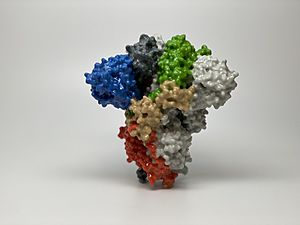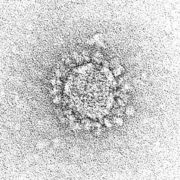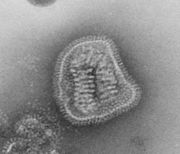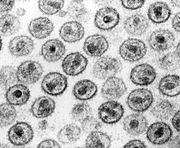Spike protein facts for kids
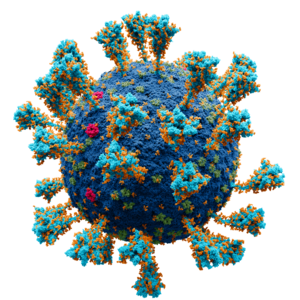
In the world of virology (the study of viruses), a spike protein is a special kind of protein. It forms a large structure that looks like a "spike" or "peplomer." These spikes stick out from the surface of many enveloped viruses. These proteins are usually glycoproteins, meaning they have sugars attached. They often come together in groups of two (dimers) or three (trimers).
Contents
What are Spike Proteins?
Spikes or peplomers are usually shaped like rods or clubs. They project from the virus's surface. Spike proteins are membrane proteins. This means they are anchored in the virus's outer layer, called the viral envelope. They have a large part that sticks out from the virus. They also have a small part inside the virus. These proteins can also connect with other viral proteins. For example, they can connect with those that form the nucleocapsid. They are often glycoproteins, which means they have sugar molecules attached to them.
How Do Spike Proteins Work?
Spikes usually play a big role in how a virus gets inside a cell. They can connect with special "receptors" on the surface of a host cell. Think of it like a key fitting into a lock. This connection helps the virus enter the cell. Some spikes can also act like enzymes. For example, the influenza virus has two surface proteins. One helps it stick to cells, and the other is an enzyme. The part of the spike that connects to the cell receptor is usually at its very tip. Many spike proteins also help the virus's outer layer (membrane) join with the host cell's membrane. Because spike proteins are on the outside of the virus, our bodies can see them. This means they can act as antigens. Antigens are substances that cause our immune system to make antibodies.
Examples of Spike Proteins
You can see spikes or peplomers in pictures taken with an electron micrograph. These pictures show enveloped viruses. Some examples include orthomyxoviruses, paramyxoviruses, rhabdoviruses, filoviruses, coronaviruses, bunyaviruses, arenaviruses, and retroviruses.
Coronaviruses have a special spike protein on their surfaces. It is called the S protein. This S protein is very important. It helps the virus get inside cells. This is the first step in a viral infection. The S protein is also very good at causing our immune system to make antibodies. Because of this, the spike protein has been a main focus for making COVID-19 vaccines. These vaccines were developed to fight the COVID-19 pandemic. This pandemic was caused by the virus SARS-CoV-2. Some types of coronaviruses also have another, shorter surface protein. It is called hemagglutinin esterase.
Influenza Viruses
Most influenza viruses have two surface proteins that act as peplomers. One is neuraminidase, which is an enzyme. The other is hemagglutinin. Hemagglutinin helps the virus attach to cells. Some influenza viruses have a single protein that does both jobs.
Retroviruses
Retroviruses, like the human immunodeficiency virus (HIV), also have surface peplomers. These are made of two proteins, gp41 and gp120. Together, they form a spike protein complex. This complex helps the virus get into cells.
Gallery
- Electron micrographs of viruses with surface spikes
See also
 In Spanish: Espícula viral para niños
In Spanish: Espícula viral para niños
- Viral entry
- Viral life cycle


